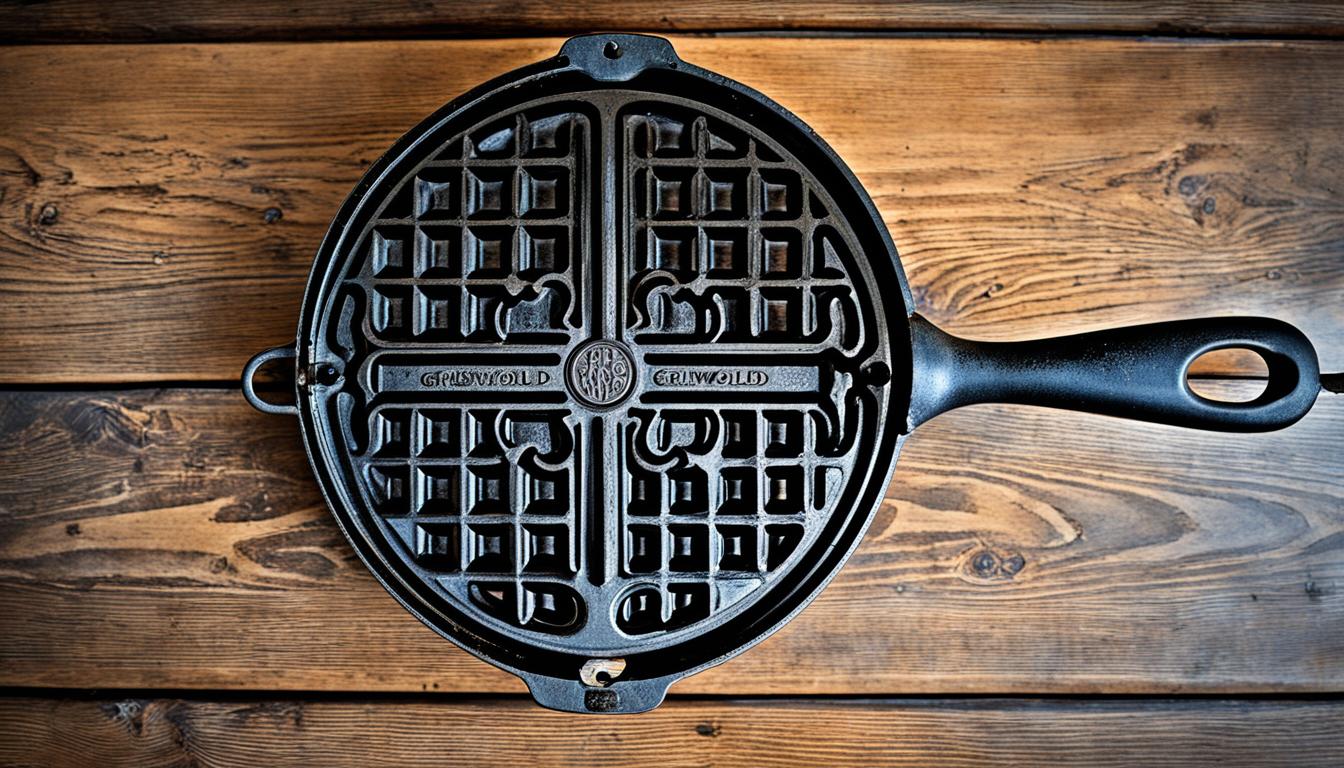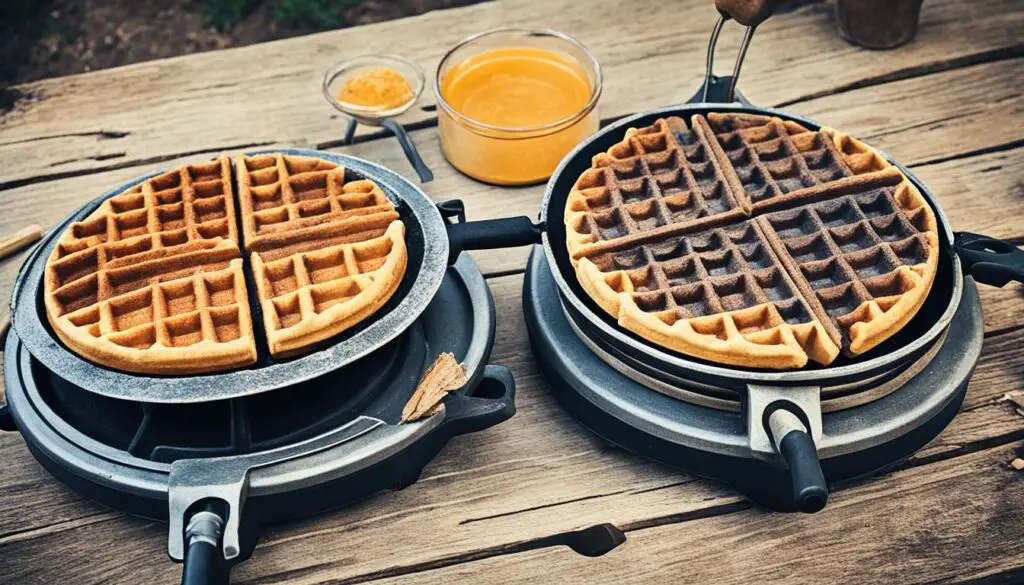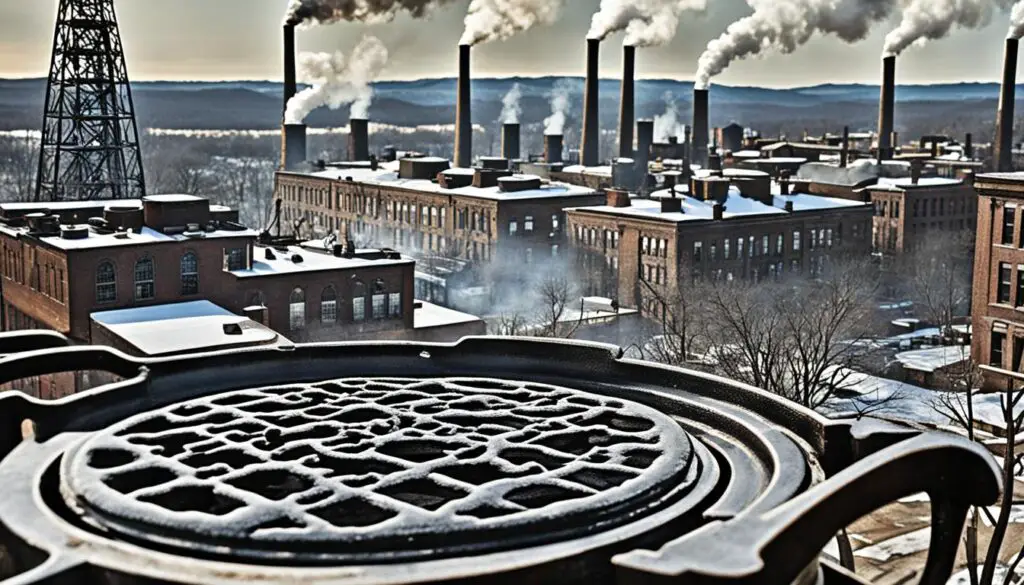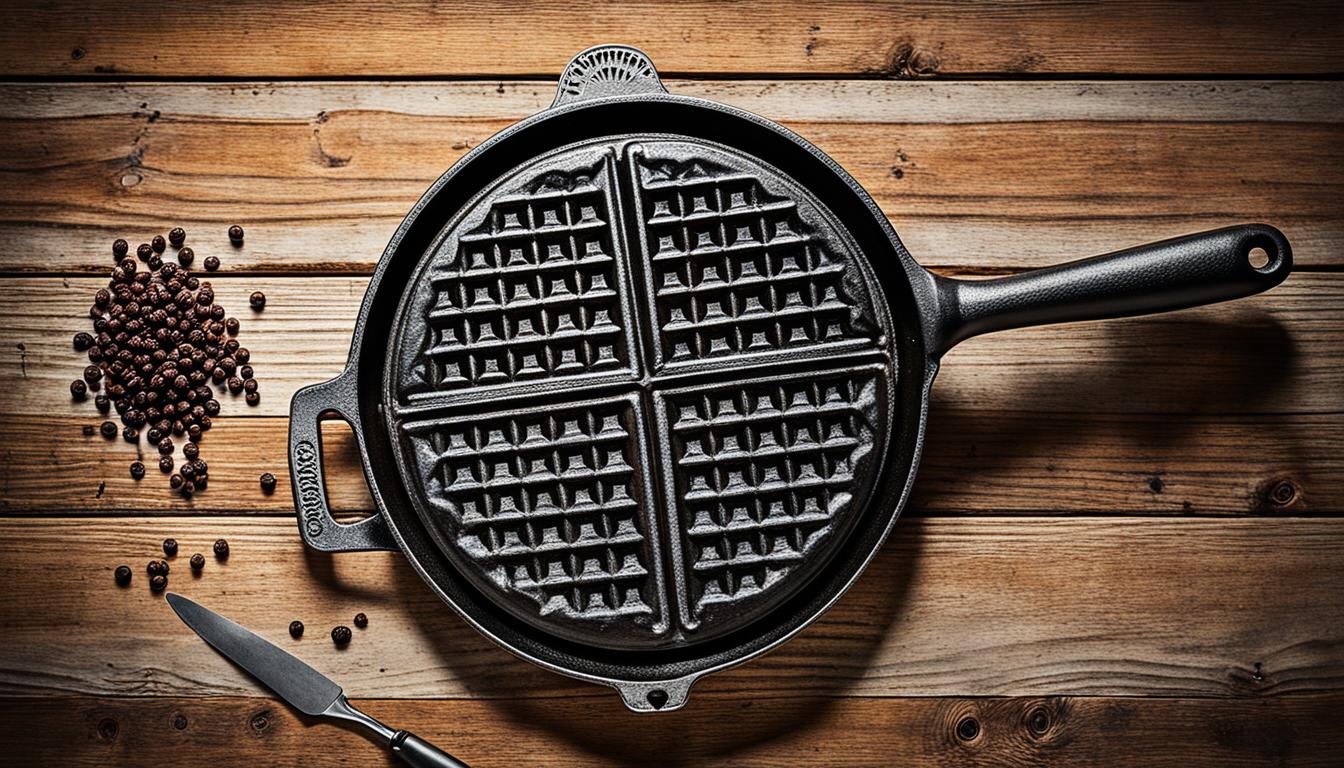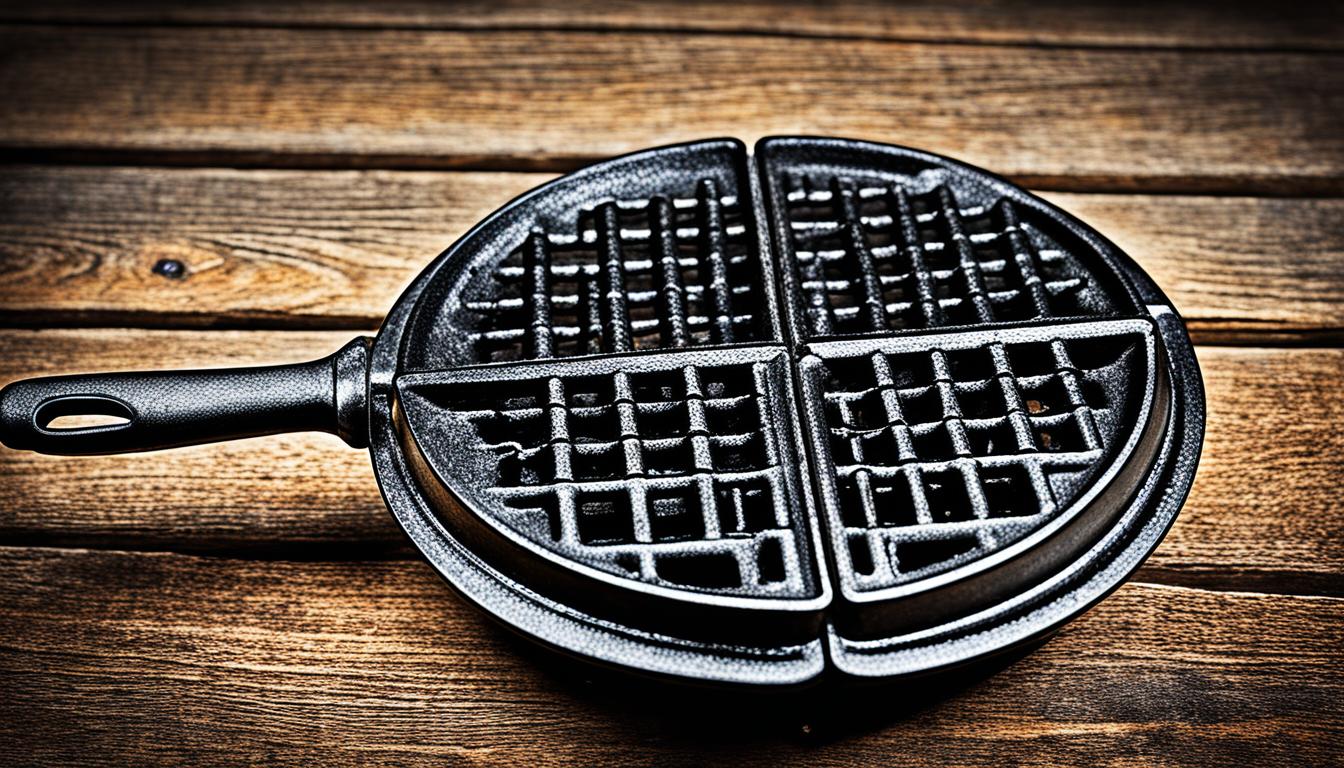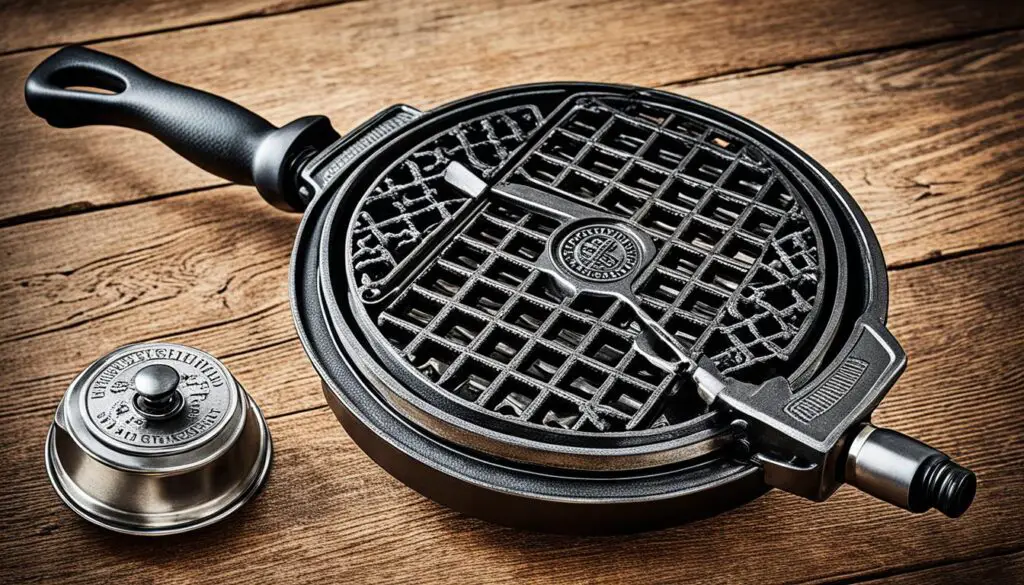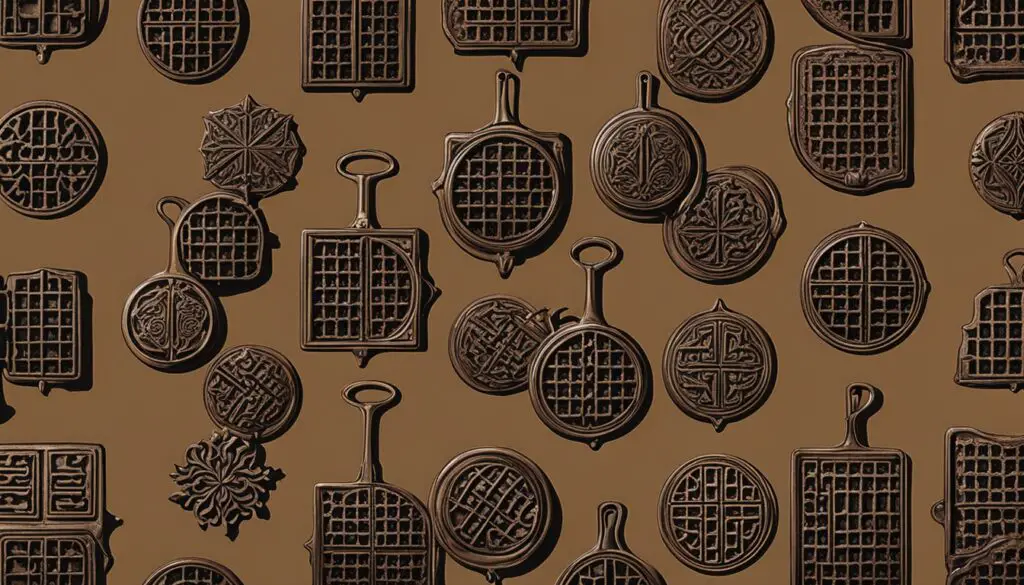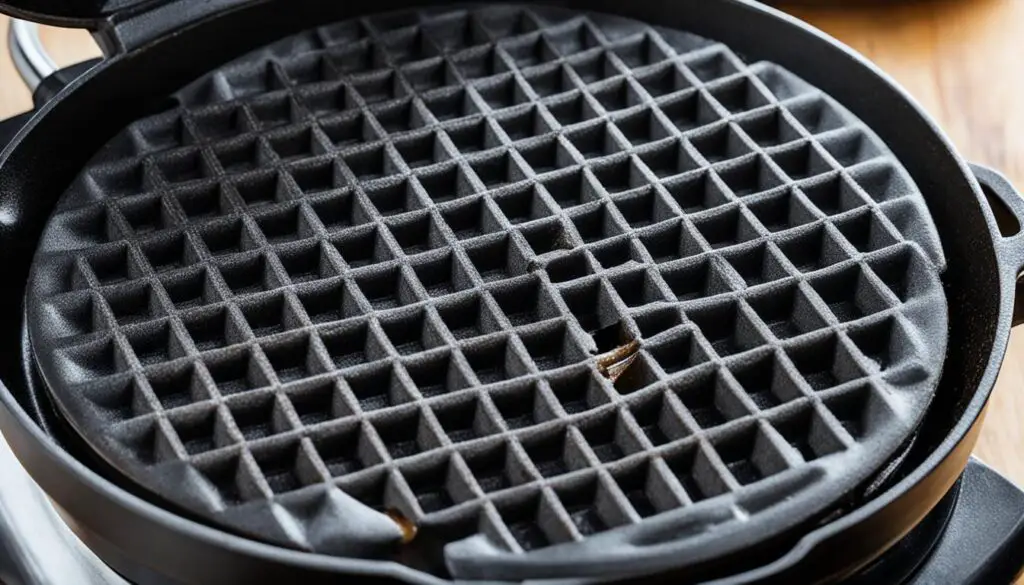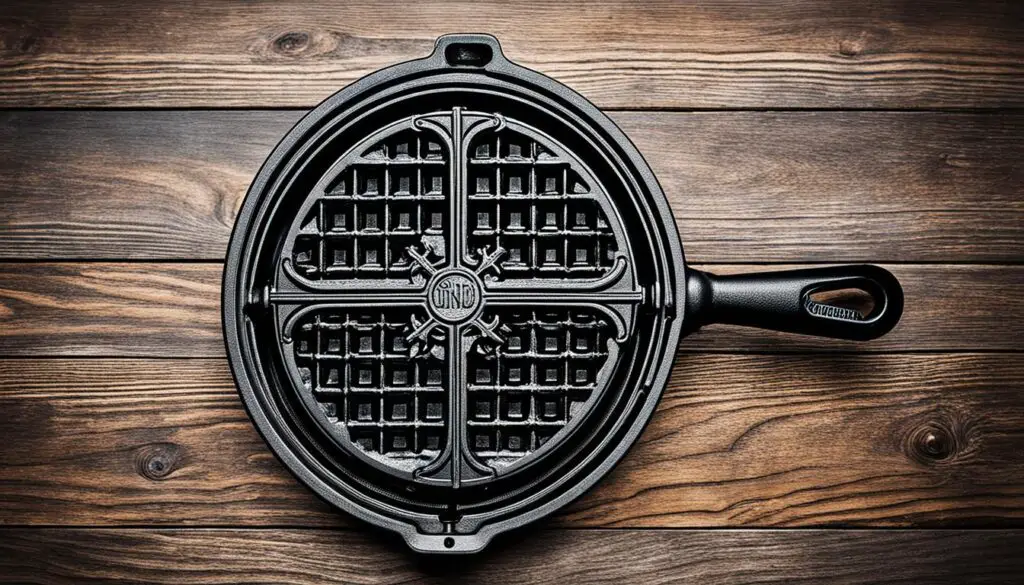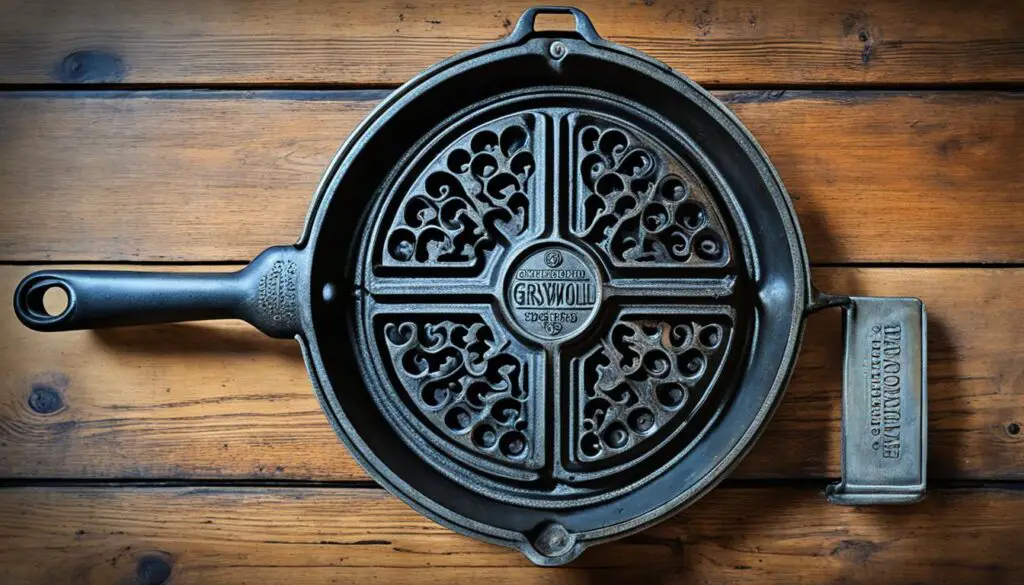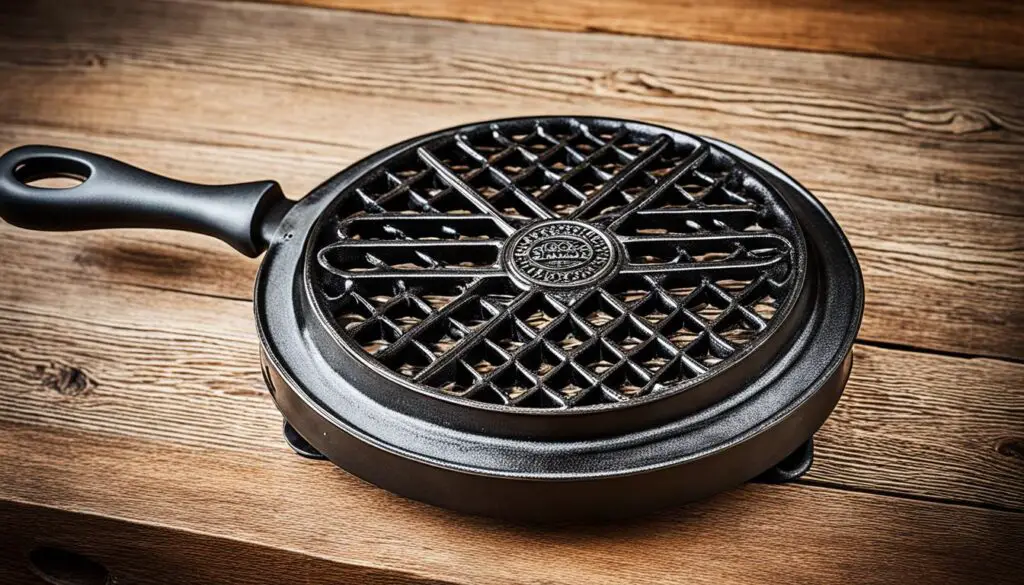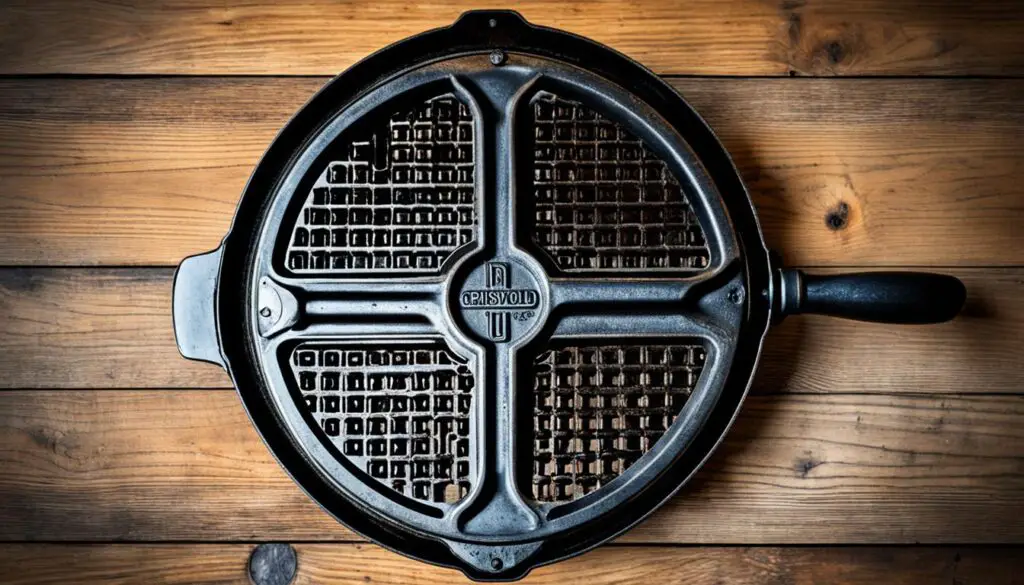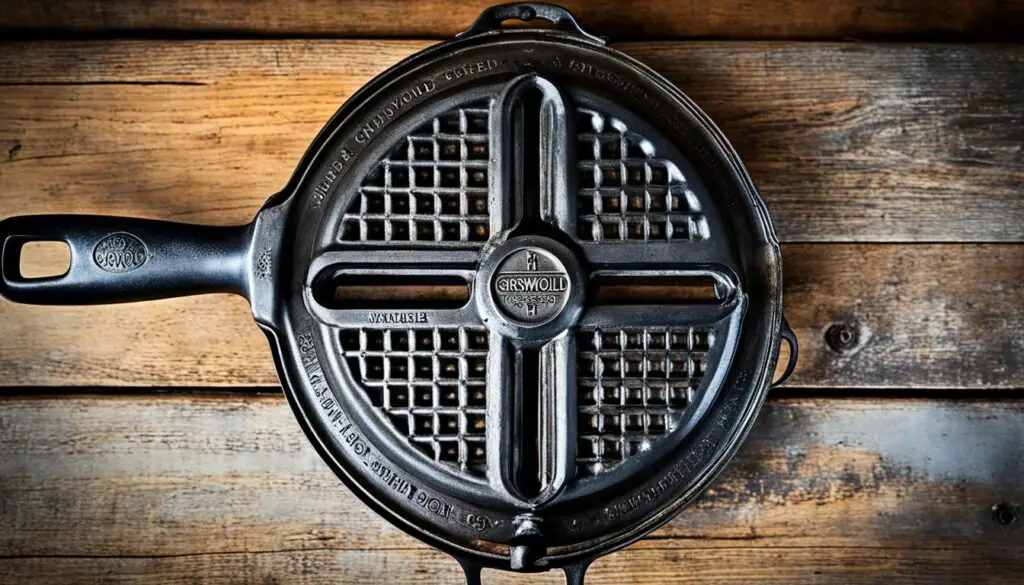Griswold cast iron waffle irons are popular among collectors because they are so durable that they can last for generations.
If you examine the excellent craftsmanship of these antique cast iron stovetop waffle irons more closely, the appeal of Griswold’s old waffle irons becomes clear. They are not just collectible. Many people love to use them because they cook waffles so well. Even though newer materials like cast aluminum heat quicker, cast iron heats more evenly and slowly, enhancing textures and flavors.
Key Takeaways
- Griswold cast iron waffle irons are highly valued collectibles because of their excellent craftsmanship and limited supply since the Griswold Manufacturing company went out of business a long time ago
- You can buy a used one for between $200 and $400 on Ebay or Etsy
- They come in various designs, including round, heart, and star shapes
- Cast iron’s density contributes to the waffle irons’ durability and weight
- Despite lower thermal conductivity, cast iron provides even heating
Amazon sells a reproduction of the Griswold cast iron waffle iron from Appalachian. It is expensive but it is the closest thing to brand new that is available. Click on the link below for more information.

Appalachian Cast Iron Great Belgian Waffle Iron
Table of Contents
- 1 The History of Waffle Irons: From Medieval Times to Griswold to Electric Waffle Makers
- 2 Griswold Manufacturing Company: A Legacy in Cast Iron
- 3 Identifying Authentic Antique Griswold Cast Iron Waffle Irons
- 4 The Anatomy of a Griswold Waffle Iron
- 5 Griswold Waffle Iron Sizes and Patterns
- 6 Collectibility and Value of Antique Griswold Cast Iron Waffle Irons
- 7 Restoration and Maintenance of Vintage Waffle Irons
- 8 Cooking with an Antique Griswold Waffle Iron
- 9 Comparing Griswold to Other Vintage Waffle Iron Brands
- 10 Where to Find Antique Griswold Cast Iron Waffle Irons
- 11 Tips for Collecting Antique Griswold Cast Iron Waffle Irons
- 12 Modern Reproductions vs. Authentic Antique Griswold Waffle Irons
The History of Waffle Irons: From Medieval Times to Griswold to Electric Waffle Makers
Early Waffle Irons: Medieval Origins
In the 13th and 14th centuries, medieval European monasteries first developed wafer-like plates used for creating communion wafers. These early hinged metal plates gradually evolved into waffle irons, with the Netherlands and Belgium playing a crucial role in their development. Bakers began experimenting with recipes, adding leavening agents that made waffles thicker and created the deep pockets we recognize today.
Evolution of Waffle Iron Designs
Waffle irons underwent significant transformations over the centuries. From simple hinged plates to more sophisticated designs, they became a culinary staple. By the 19th century, numerous U.S. cast iron manufacturers began producing waffle irons, with each company offering unique styles and features that revolutionized home cooking.
Griswold’s Contribution to the Waffle Iron Market
Griswold Manufacturing Company, founded in 1865 in Erie, Pennsylvania, made a remarkable impact on waffle iron production. They were renowned for their precision casting techniques and intricate design patterns. Griswold offered an extensive range of waffle iron sizes, shapes, and styles that catered to both home cooks and commercial kitchens.
While traditional cast iron waffle irons have become less common, they remain highly valued by cooking enthusiasts and collectors.
Today, there are very few cast iron waffle irons for sale because they are more expensive to manufacture than electric ones are and consumers prefer the electric waffle maker’s faster cooking times and ease of use.
Contemporary manufacturers like Cuisinart and Breville now offer advanced models with digital controls and non-stick surfaces that make waffle preparation easier than ever. Electric waffle makers like the Greenpan Elite even come with removable plates that are ceramic coated, making them just as safe to cook with as cast iron is.
| Era | Key Features | Popular Brands |
|---|---|---|
| 13th-14th Century | Monastery wafer plates | Monastery craftsmen |
| 19th Century | Cast iron, various patterns | Griswold, Wagner |
| Early 20th Century | First electric models | General Electric |
| Modern Era | Digital controls, non-stick | Cuisinart, Breville |
Griswold Manufacturing Company: A Legacy in Cast Iron
Founded in 1865, Griswold Manufacturing Company emerged as a pivotal manufacturer in the American cookware industry. Established in Erie, Pennsylvania, the company began as a small foundry but quickly distinguished itself through exceptional quality and innovative manufacturing techniques. Griswold’s rise epitomized the industrial innovation and craftsmanship of late 19th-century American manufacturing.
The Cultural Impact of Griswold Waffle Irons in American Kitchens
Griswold waffle irons revolutionized home cooking from the late 1800s through the early 1900s. Their precisely engineered cast iron cookware marked a significant technological transition in American culinary practices. As households moved from cooking over open fires to using standardized stoves, Griswold’s products became instrumental in this transformation.
The company’s waffle irons were renowned for their superior heat retention and durability. Unlike earlier cookware, Griswold’s products were meticulously crafted to ensure even heating and long-lasting performance. Families often passed down these high-quality pieces through generations, with many Griswold items becoming cherished heirlooms.
Griswold’s product line extended far beyond waffle irons. Their comprehensive range of cast iron cookware included skillets, griddles, dutch ovens, and specialty cooking implements. Each piece was distinguished by the company’s iconic cross logo, which became a mark of quality recognized nationwide.
The company’s manufacturing approach was ahead of its time. They implemented rigorous quality control and used advanced casting techniques that set new standards in the cookware industry. Their commitment to excellence made Griswold synonymous with reliable, high-performance kitchen equipment.
In 1957, Griswold Manufacturing closed its doors, marking the end of an era in American cookware production. The Wagner Manufacturing Company acquired Griswold’s assets, but the brand’s legacy continued. Today, Griswold cast iron pieces are highly prized by collectors and culinary historians, representing a golden age of American manufacturing craftsmanship.
| Modern Waffle Maker | Power (Watts) | Temperature Settings |
|---|---|---|
| GreenPan Elite 4-slice | 1600 | LCD display, pre-programmed types |
| Cuisinart WAF-RP10 | 800 | Adjustable |
| All Clad Digital Gourmet | 1600 | 7 precision settings |
| Cuisinart WAF-300 | 1200 | 6 browning controls |
| Krups GQ502D Belgian | 1200 | 5 temperature levels |
Identifying Authentic Antique Griswold Cast Iron Waffle Irons
For collectors and culinary historians, authenticating Griswold cast iron waffle irons is a nuanced art. These remarkable pieces of American manufacturing history require careful examination to verify their genuine origins.
Trademark Variations and Their Significance
Griswold's trademarks tell a rich story of the company's manufacturing history. The trademark evolution can be categorized into several distinct periods:
1. Early Erie Period (1865-1884):
– First marks featured "ERIE" foundry mark
– Simple, less detailed logos
– Typically smaller and less elaborate
– Collectors consider these marks extremely rare
2. Cross Logo Period (1884-1909):
– Introduction of the iconic cross trademark
– More refined and consistent design
– Typically surrounded by "GRISWOLD MFG. CO." text
– Indicates transition to more standardized manufacturing
3. Large Cross Logo Period (1909-1930):
– Larger, more prominent cross logo
– Added text "ERIE, PA, U.S.A."
– Represents the company's peak manufacturing era
– Most common trademark among collectors
4. Late Period Marks (1930-1957):
– Slightly modified cross logo
– Smaller, less detailed
– Reflects changes in manufacturing techniques
– Marks from this period are less valuable to collectors
Each trademark variation provides crucial information about the waffle iron's age, manufacturing process, and potential historical significance.
Pattern Numbers and Their Meanings
Griswold's pattern numbering system was a sophisticated method of tracking and identifying their cookware:
Numbering System Breakdown:
– Pattern numbers ranged from 0 to 299
– Each number represented a specific:
Cookware type
Size
Specific design variation
Manufacturing specification
Examples of Notable Pattern Numbers:
– Pattern 18: Round waffle iron (most common collector's item)
– Pattern 20: Square waffle iron
– Lower numbers (0-50): Generally considered more rare and valuable
– Pattern numbers often stamped on both handles for verification
Coding Complexity:
– Some numbers had additional suffixes (A, B, C)
– Suffixes indicated minor design modifications
– Entire pattern number system changed multiple times between 1865-1957
Collector's Importance:
– Matching pattern numbers crucial for authentication
– Helps determine exact manufacturing date
– Provides insight into production variations
– Can significantly impact piece's collector value
Unique Griswold Design Features
Griswold's manufacturing excellence was evident in multiple design innovations:
Hinge Designs:
– Six distinct hinge types developed over company's history
– Each hinge type represented technological advancement
– Variations included:
Single-pivot hinges
Double-pivot hinges
Reinforced connection points
Precision-engineered movement mechanisms
Surface and Casting Characteristics:
– Exceptionally smooth casting surfaces
– Minimal surface imperfections
– Precise metal grain consistency
– Thin, uniform wall thickness
– Advanced sand-casting techniques
Unique Design Elements:
– Proprietary leveling tabs for consistent cooking
– Precisely machined contact surfaces
– Integrated heat distribution channels
– Ergonomic handle designs
– Innovative weight distribution techniques
Technological Innovations:
– Used advanced metallurgical techniques
– Developed proprietary iron alloy mixtures
– Implemented strict quality control processes
– Created cookware that was both functional and aesthetically pleasing
Each design feature represented Griswold's commitment to manufacturing excellence and helped distinguish their products from competitors.
How to Spot Reproductions or Fakes
Identifying authentic Griswold pieces requires careful scrutiny:
– Examine surface finish (authentic pieces have smooth, consistent casting)
– Check trademark clarity and period-correct details
– Verify pattern number consistency
– Consult expert resources and reputable collector guides
When uncertain, seek authentication from professional antique cookware experts or specialized collectors.
Waffle makers with ceramic coated cooking plates are a safe, modern option without Teflon’s health concerns. They offer a non-stick surface without the worries.
| Feature | Authentic Griswold | Reproduction |
|---|---|---|
| Trademark | Crisp, historically consistent | Blurry, anachronistic details |
| Pattern Numbers | Precisely matched on both paddles | Inconsistent or incorrectly stamped |
| Casting Quality | Smooth, with refined details | Rough, imprecise surface |
| Hinge Design | Engineered to specific Griswold standards | Lacks precision of original designs |
The Anatomy of a Griswold Waffle Iron
Griswold waffle irons represent a pinnacle of 19th and early 20th-century metalworking and culinary engineering. These meticulously crafted cooking implements showcase remarkable design sophistication and functional excellence.
The fundamental structure of a Griswold waffle iron consists of two primary components: paddles and a base. Contrary to the original text, paddles were exclusively made of cast iron, not aluminum. Each paddle features precisely engineered waffle grid patterns that ensured consistent cooking and distinctive waffle shapes. The base, always constructed from high-quality cast iron, provided critical heat distribution and stability.
Specialized Surface Treatments:
– Japanning: A black lacquer coating used for both aesthetic and protective purposes
– Some models featured intricate surface treatments to enhance durability
– Different finishes indicated various manufacturing periods and design innovations
Handle Design Evolution:
Griswold developed multiple handle configurations throughout their manufacturing history:
– Turned wood handles: Provided insulation and classic aesthetic
– Steel coil handles: Offered enhanced strength and heat resistance
– Integrated iron handles: Ensured seamless design and improved structural integrity
– Folding handles: Introduced for compact storage in later models
Each handle design represented a careful balance between functionality, user comfort, and manufacturing capabilities.
Hinge Mechanism Innovations:
Griswold’s hinge designs were a testament to their engineering prowess:
– Six distinct hinge types developed over the company’s operational years
– Precision-engineered to ensure:
* Smooth opening and closing
* Even pressure distribution
* Consistent cooking performance
– Hinges were carefully machined to minimize wear and maximize durability
Material Composition:
– Primary material: High-quality gray cast iron
– Carefully selected iron alloys
– Precise metallurgical techniques ensuring:
* Uniform metal grain
* Exceptional heat retention
* Long-lasting durability
To keep cast iron waffle irons in good shape, proper cleaning is a must. Here’s a simple guide:
| Preservation Step | Detailed Action | Recommended Tools/Materials | Purpose |
|---|---|---|---|
| 1. Initial Cleaning | Remove rust and surface debris |
– Stiff-bristled brush – Fine-grit sandpaper – Wire wool (0000 grade) |
Prepare surface for restoration |
| 2. Thorough Washing | Remove cleaning residue and contaminants |
– Mild, non-detergent soap – Warm water – Soft cleaning cloth |
Ensure clean surface for seasoning |
| 3. Complete Drying | Eliminate all moisture |
– Clean lint-free cloth – Paper towels – Low-heat oven |
Prevent rust formation |
| 4. Seasoning | Create protective non-stick layer |
– Flaxseed oil – Grapeseed oil – Cast iron seasoning wax |
Develop protective coating |
| 5. Proper Storage | Preserve restored condition |
– Silica gel packets – Dry, temperature-controlled area – Cloth or paper wrap |
Prevent moisture and oxidation |
Griswold Waffle Iron Sizes and Patterns
Geometric Design Variations
Griswold's waffle iron designs represented a sophisticated approach to culinary engineering, with two primary geometric configurations:
Round Waffle Irons:
– Superior heat distribution characteristics
– More traditional manufacturing approach
– Typically preferred by conservative home cooks
– Easier to handle and store
– Produced more uniformly cooked waffles
Square Waffle Irons:
– Maximized cooking surface area
– Allowed for more batter volume
– Appealed to larger families and commercial kitchens
– Represented manufacturing innovation
– Provided more consistent edge-to-center cooking
Cultural Waffle Patterns: American vs. French (Belgian) Designs
Griswold's waffle iron designs reflected distinct culinary traditions:
American Waffle Pattern:
– Characterized by shallow paddle depths
– Smaller, more compact grid nubs
– Designed for crisp, thin waffles
– Typically 1/4 to 1/2 inch thick
– Ideal for quick, light breakfast preparations
French (Belgian) Waffle Pattern:
– Significantly deeper paddle impressions
– Larger, more widely spaced grid nubs
– Created thick, fluffy waffles
– Approximately 3/4 to 1 inch thick
– Inspired by European culinary traditions
– Required more batter and longer cooking times
Specialty and Collector's Edition Designs
Beyond standard designs, Griswold produced remarkable specialty waffle irons:
Signature Specialty Patterns:
1. Heart-Star Pattern:
– Sizes 8 and 9
– Extremely rare collector's items
– Decorative and functional design
– Represents peak of Griswold's artistic manufacturing
2. Playing Card Suit Designs:
– Unique shapes mimicking card suits
– Limited production runs
– Highly sought by collectors
– Demonstrated Griswold's manufacturing versatility
3. Additional Rare Patterns:
– Geometric shapes
– Regional design variations
– Experimental manufacturing techniques
| Design Type | Pattern Characteristics | Size Range | Collector's Significance |
|---|---|---|---|
| Round American |
– Shallow grid – Compact nubs – Crisp waffle style |
6-9 inches | Standard collector's item |
| Square Belgian |
– Deep grid impressions – Large spaced nubs – Fluffy waffle style |
6-9 inches | Culinary tradition representation |
| Heart-Star |
– Decorative shape – Limited production – Artistic design |
8-9 inches | Extremely rare collector's piece |
| Playing Card Suits |
– Unique suit-inspired shapes – Experimental design – Manufacturing showcase |
Varies | Highly unique collector's item |
Collectibility and Value of Antique Griswold Cast Iron Waffle Irons
Griswold Cast Iron Collectibles: Market Dynamics and Valuation
The market for Griswold collectibles has experienced significant evolution, driven by several key factors:
Valuation Determinants:
– Condition of the piece
– Rarity of the specific pattern
– Completeness of original components
– Historical significance
– Manufacturing period
– Preservation quality
Price Stratification:
– Entry-level pieces: $100 – $250
– Mid-range collectibles: $250 – $750
– Rare, pristine examples: $750 – $3,000
– Exceptional, museum-quality pieces: $3,000+
Collector's Market Insights:
– Online platforms like eBay dominate sales
– Specialized antique cookware forums provide valuation resources
– Auction houses increasingly feature high-end Griswold pieces
– Authentication becomes critical for high-value transactions
Purchasing Strategies:
– Start with common, more affordable models
– Gradually build expertise
– Focus on condition and authenticity
– Understand historical context
– Network with experienced collectors
Restoration and Maintenance of Vintage Waffle Irons
Comprehensive Restoration Methodology
Professional-Level Restoration Techniques:
Initial Assessment:
– Detailed visual inspection
– Identify structural integrity
– Map existing damage
– Determine restoration approach
Cleaning Protocols:
– Mechanical cleaning methods
Fine-grade steel wool (0000)
Specialized cast iron cleaning tools
Careful scraping techniques
– Chemical cleaning considerations
Mild acid solutions
Electrolysis for severe rust
pH-neutral cleaning agents
Advanced Seasoning Techniques
Seasoning Methodology:
– Preparation
Completely dehydrate cast iron
Remove all moisture traces
Ensure surface is absolutely clean
– Oil Selection Criteria:
High smoke point oils
Polymerization potential
Non-rancid characteristics
Seasoning Process:
1. Apply ultra-thin oil layer
2. Distribute evenly using lint-free cloth
3. Bake at precisely 450-500°F
4. Allow complete cooling between layers
5. Repeat 3-4 times for optimal protection
Preservation of Historical Integrity
Japanning Preservation Strategies:
– Minimal intervention approach
– Professional conservation techniques
– Documenting original surface characteristics
– Consulting restoration specialists for complex pieces
| Seasoning Oil | Smoke Point | Polymerization Quality | Collector Recommendation |
|---|---|---|---|
| Grapeseed Oil | 420°F | Excellent | Highly Recommended |
| Avocado Oil | 520°F | Superior | Premium Choice |
| Vegetable Oil | 400°F | Good | Acceptable |
| Flaxseed Oil | 225°F | Moderate | Limited Use |
Cooking with an Antique Griswold Waffle Iron
Thermal Dynamics and Cooking Characteristics
Griswold Waffle Iron Cooking Fundamentals:
Heat Retention Properties:
– Superior thermal mass of cast iron
– Exceptional even heat distribution
– Consistent temperature maintenance
– Minimal heat fluctuation during cooking
Cooking Surface Advantages:
– Natural non-stick characteristics
– Develops superior caramelization
– Creates complex flavor profiles
– Produces consistently crisp exterior
Cooking Adaptability:
– Functional across multiple heat sources
Traditional wood stoves
Modern electric stovetops
Gas ranges
Outdoor cooking platforms
Advanced Cooking Techniques
Precision Waffle Preparation Strategies:
Pre-Cooking Preparation:
– Thorough iron preheating of both sides
– Even heat distribution check
– Surface temperature calibration
– Minimal oil/fat application
Batter Considerations:
– Higher fat content recommendations
– Traditional recipe adaptations
– Moisture content management
– Protein structure optimization
Cooking Process:
1. Precise batter portioning
2. Controlled temperature maintenance
3. Strategic iron rotation
4. Steam release monitoring
5. Careful waffle extraction
Culinary Versatility
Waffle Variation Potential:
– Traditional buttermilk recipes
– Gluten-free formulations
– Vegan batter adaptations
– Experimental flavor combinations
– Cultural recipe interpretations
Comparing Griswold to Other Vintage Waffle Iron Brands
Comparative Brand Analysis
Vintage Cast Iron Waffle Iron Manufacturers:
Comprehensive Brand Evaluation:
Griswold Manufacturing:
– Pioneering design innovation
– Extensive pattern diversity
– Precision engineering
– Superior metallurgical techniques
– Highest collector desirability
Wagner Ware:
– Renowned surface smoothness
– Consistent manufacturing quality
– Reliable heat distribution
– Strong regional market presence
Favorite Cookware:
– Aesthetically distinctive designs
– Decorative manufacturing approach
– Limited production runs
– Collector's artistic appreciation
Wapak Casting:
– Unique hinge engineering
– Experimental manufacturing techniques
– Limited production scale
– Niche collector market
| Brand | Manufacturing Distinguishing Features | Collector Valuation | Historical Significance |
|---|---|---|---|
| Griswold |
– Multiple size ranges – Intricate pattern variations – Precision casting |
Highest (90-100%) | Industry Leader |
| Wagner |
– Smooth cooking surfaces – Consistent quality – Refined manufacturing |
High (75-85%) | Significant Competitor |
| Favorite |
– Decorative designs – Limited production – Artistic approach |
Medium (60-70%) | Regional Significance |
| Wapak |
– Unique hinge mechanisms – Experimental techniques – Small-scale production |
Low-Medium (40-55%) | Niche Historical Interest |
Where to Find Antique Griswold Cast Iron Waffle Irons
Comprehensive Acquisition Strategies
Griswold Cast Iron Waffle Iron Procurement Channels:
Primary Acquisition Methods:
– Local antique marketplace exploration: These physical venues provide unique opportunities to discover Griswold waffle irons through direct, hands-on searching with the added benefit of potentially negotiating prices.
– Online digital platforms: Digital marketplaces such as eBay have revolutionized collector acquisition by providing access to a global inventory of antique cookware from sellers worldwide.
Amazon sells a reproduction of the Griswold cast iron waffle iron from Appalachain. It is expensive but it is the closest thing to brand new that is available. Click on the link below for more information.

Appalachian Cast Iron Great Belgian Waffle Iron
Learn More
– Specialized collector networks: These networks connect passionate collectors who often share rare finds and insider knowledge about Griswold waffle irons, creating a community of enthusiasts.
– Regional collector conventions: Conventions offer a concentrated marketplace where enthusiasts can meet, trade, and learn about vintage cast iron cookware, often featuring expert appraisals and demonstrations.
– Auction house acquisitions: Professional auction houses frequently feature high-quality, rare Griswold pieces that are meticulously authenticated and documented, providing a reliable source for serious collectors.
Strategic Considerations:
– Thorough market research: Understanding the historical context and variations of Griswold waffle irons can help collectors make informed purchasing decisions and avoid potential misidentifications.
– Price point understanding: Knowing the current market value helps prevent overpaying and identifies potential investment opportunities in the vintage cookware market.
– Authenticity verification: Developing skills to recognize genuine Griswold pieces protects collectors from purchasing counterfeit items and ensures collection quality.
– Condition assessment: Carefully evaluating the physical state of a waffle iron determines its collectible value and potential restoration needs, which can significantly impact its market price.
– Historical provenance investigation: Tracing the origin and history of a specific waffle iron can significantly enhance its collectible appeal and provide deeper appreciation of its historical significance.
Acquisition Channel Deep Dive
Detailed Exploration of Procurement Sources:
1. Brick-and-Mortar Antique Venues:
– Local antique shops: These stores often house hidden treasures that require patient and systematic searching by knowledgeable collectors.
– Regional flea markets: Flea markets provide an unpredictable but exciting hunting ground for vintage cast iron cookware with potential for unexpected discoveries.
– Collector swap meets: These events create unique opportunities for direct trading and networking among passionate Griswold waffle iron enthusiasts.
– Estate sale opportunities: Estate sales can reveal well-preserved collections that have been carefully maintained by previous owners.
Advantages:
– Direct physical inspection: Allows collectors to personally examine the waffle iron's condition, authenticity, and unique characteristics.
– Immediate authentication: Provides the ability to verify the piece's originality on the spot, reducing the risk of purchasing a replica.
– Potential negotiation: Offers the chance to discuss pricing directly with sellers and potentially secure a better deal.
– Serendipitous discoveries: Creates opportunities for unexpected and exciting finds that might not be available through traditional purchasing channels.
2. Digital Marketplace Platforms:
– eBay: Offers a vast selection of Griswold waffle irons with detailed seller descriptions and extensive photographic evidence.
– Etsy: Provides a platform for vintage and handcrafted items, often featuring curated collections of antique cookware.
– Specialized cookware forums: These online communities allow collectors to connect, share information, and potentially find rare pieces.
– Collector-specific websites: Dedicated platforms offer focused resources and marketplaces for serious cast iron enthusiasts.
Strategic Considerations:
– Comprehensive price comparison: Allows collectors to evaluate market prices across multiple platforms and make informed purchasing decisions.
– Detailed seller reputation analysis: Helps minimize the risk of fraudulent transactions by examining seller feedback and history.
– Shipping cost evaluation: Enables collectors to factor in additional expenses when determining the total cost of acquisition.
– Return policy understanding: Provides protection and recourse in case the purchased item does not meet expected condition or authenticity standards.
3. Specialized Cast Iron Dealers:
– Authenticated vintage cookware specialists: Offer expert verification and often provide detailed historical context for their inventory.
– Professional restoration experts: Can provide comprehensive assessment and potential restoration services for acquired pieces.
– Collector-focused businesses: Cater specifically to the needs and interests of serious cast iron collectors.
– Museum-affiliated vendors: Often provide the highest level of authentication and historical documentation.
Procurement Benefits:
– Guaranteed authenticity: Provides peace of mind through professional verification processes.
– Comprehensive historical documentation: Offers detailed provenance and historical background for each piece.
– Expert restoration services: Allows collectors to professionally maintain and preserve their acquisitions.
– Rare model accessibility: Provides access to hard-to-find and unique Griswold waffle iron models.
| Acquisition Channel | Procurement Advantages | Potential Limitations | Recommended Approach |
|---|---|---|---|
| Antique Physical Locations |
– Direct inspection – Negotiation potential – Immediate acquisition |
– Limited inventory – Inconsistent availability – Time-intensive search |
Regular, systematic exploration |
| Online Marketplaces |
– Extensive selection – Global accessibility – Convenient searching |
– Cannot physically inspect – Potential misrepresentation – Shipping complexities |
Comprehensive seller vetting |
| Specialty Dealers |
– Guaranteed authenticity – Expert knowledge – Restoration services |
– Higher price points – Limited inventory – Specialized market |
Strategic, targeted acquisition |
Tips for Collecting Antique Griswold Cast Iron Waffle Irons
Advanced Collector's Authentication Protocol
Comprehensive Evaluation Methodology:
Authentication Criteria:
– Pattern number verification
– Trademark cross-referencing
– Structural integrity assessment
– Manufacturing period identification
– Originality confirmation
Detailed Inspection Parameters:
1. Structural Components:
– Complete set verification
– Hinge mechanism assessment
– Surface consistency evaluation
– Matching serial numbers
2. Condition Assessment:
– Rust penetration analysis
– Structural damage investigation
– Original surface preservation
– Restoration potential evaluation
3. Authenticity Verification:
– Historical documentation review
– Expert consultation
– Comparative analysis with known authentic pieces
– Metallurgical composition testing
Market Value Determination Strategies
Pricing and Valuation Approaches:
Reference Resources:
– Blue Book of Cast Iron Values
– Red Book of Collectible Cookware
– Online collector forums
– Specialized auction records
– Griswold Collector's Association guidelines
Valuation Factors:
– Historical period
– Manufacturing quality
– Condition
– Rarity
– Completeness
– Provenance
Recommended Verification Methods:
– Multiple price source consultation
– Recent auction record analysis
– Professional appraiser evaluation
– Collector community consensus
Modern Reproductions vs. Authentic Antique Griswold Waffle Irons
Many Griswold reproductions are available today, but they can’t beat the charm of the real antiques. Griswold Manufacturing started in 1865 and made these waffle irons for over 90 years. They were popular from the 1870s to the 1930s.
It’s easy to spot a fake cast iron Griswold if you know what to look for. Genuine Griswold pieces have unique numbers and patterns. Because of this, fakes often miss the mark. The age signs on the authentic pieces can’t be duplicated.
It’s all about the detail for me when I compare. The quality of the cast, the precision of the marks, and the make is unmatched in real Griswold waffle irons. Their use of enameled cast iron in the 1920s shows they were always innovating.
| Feature | Authentic Griswold | Modern Reproduction |
|---|---|---|
| Age | 1870s-1957 | Contemporary |
| Logo Variations | Multiple, evolving over time | Usually one standard logo |
| Patina | Natural, developed over decades | Artificially aged or none |
| Casting Quality | Superior, smooth finish | Often rougher, less refined |
Collectors value real Griswold waffle irons for their history and makesmanship. Even though fakes can look the part, they miss the spirit of the antique ones. I recommend studying the details closely before you buy. That’s how you can spot the true antiques from the copies.
